Understanding the Foundations of Effective Teamwork
The Psychology Behind Successful Collaboration
Workspace collaboration isn’t just about putting talented people in a room together—it’s deeply rooted in psychology. At the heart of successful teams lies psychological safety, a concept pioneered by Harvard researcher Amy Edmondson. When team members feel safe to take risks without fear of embarrassment or rejection, innovation flourishes.
Psychological safety creates an environment where people freely share ideas, admit mistakes, and ask questions. In teams with high psychological safety, members speak up about concerns, offer creative solutions, and challenge the status quo—all critical behaviors for solving complex problems. Research published in Current Opinion in Psychology shows that teams with this foundation outperform others by a remarkable 23%.
Trust acts as the building block of effective teamwork. When team members trust each other’s intentions and abilities, they’re more willing to be vulnerable, depend on one another, and collaborate authentically. Trust develops through consistent behavior, demonstrated competence, and genuine care for colleagues’ wellbeing.
Teams also benefit tremendously from diverse thinking styles. Analytical thinkers bring precision and logic, creative thinkers generate novel solutions, practical thinkers ensure implementable ideas, and relationship-focused thinkers maintain group harmony. This cognitive diversity, when properly harnessed, leads to more robust decision-making and innovative problem-solving.
Core Elements of High-Performing Teams
High-performing teams don’t happen by accident. They share several key characteristics that separate them from average groups:
First, they rally around a clear shared purpose and well-defined goals. Everyone understands not just what they’re doing, but why it matters. This clarity creates alignment and motivates sustained effort, especially during challenging periods.
Successful teams also feature complementary skills with defined roles and responsibilities. Members know their unique contributions and how they fit into the bigger picture. This clarity eliminates confusion and reduces duplicated efforts.
Established norms govern how team members interact, communicate, and make decisions. These “rules of engagement” might include expectations about meeting behavior, conflict resolution approaches, or communication preferences. Harvard Business Review research indicates that how teams communicate is often more important than who makes up the team.
Lastly, top teams embrace continuous improvement. They regularly reflect on processes, seek feedback, and adapt accordingly. This learning mindset ensures they evolve rather than stagnate.
Common Barriers to Effective Teamwork
Even with strong foundations, teams face potential obstacles:
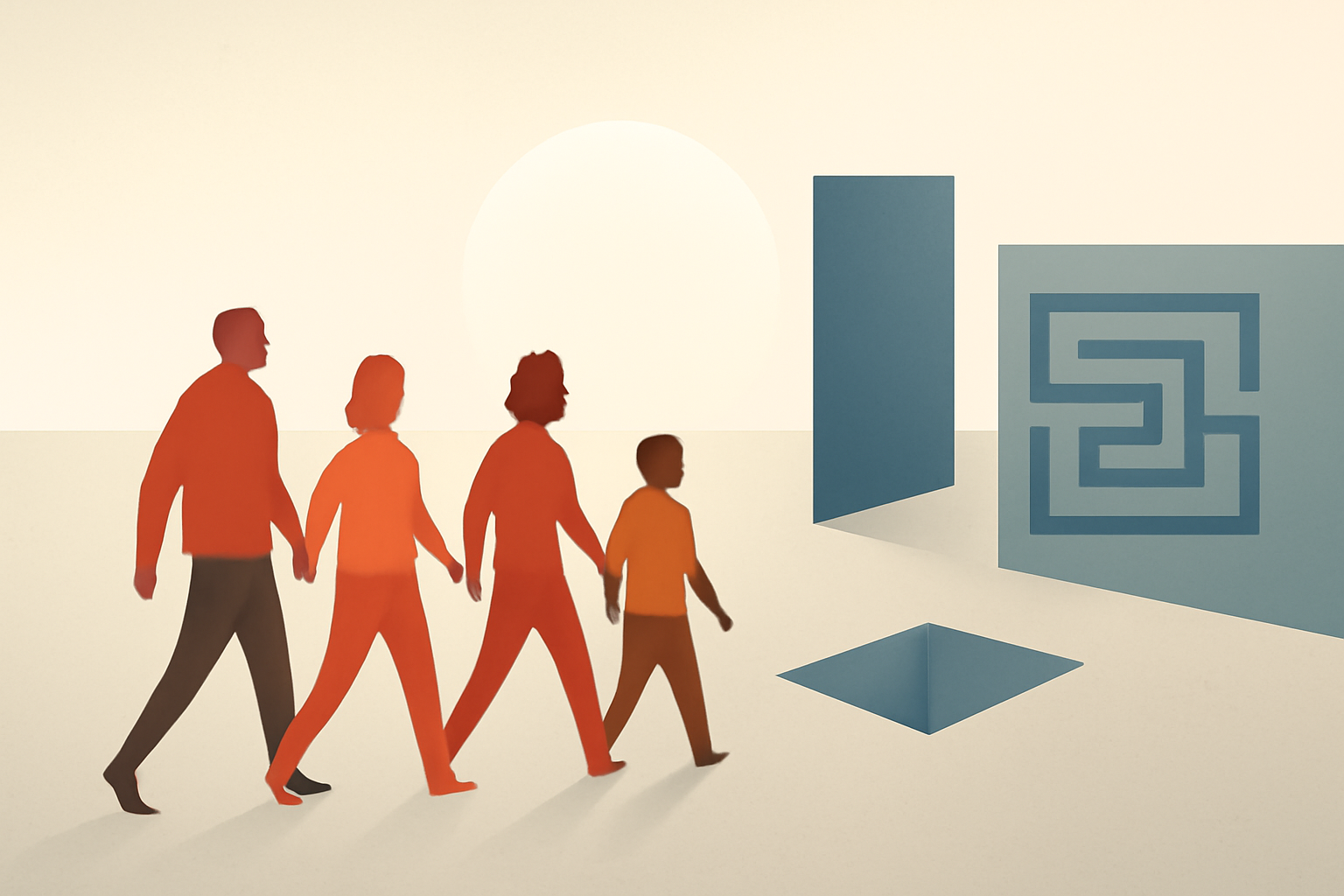
Communication breakdowns occur when messages get lost, misinterpreted, or simply not shared. These gaps create confusion, missed opportunities, and sometimes resentment.
Siloed thinking happens when team members focus exclusively on their individual or departmental concerns rather than overall team objectives. This narrow perspective limits collaboration and creates unnecessary friction.
Unresolved conflicts and interpersonal tensions drain energy and attention from productive work. Left unchecked, these issues can permanently damage working relationships and team effectiveness. Gallup research shows that poor conflict management significantly impacts employee engagement and retention.
Finally, unclear decision-making processes lead to analysis paralysis, confusion about who has final authority, and inconsistent outcomes. Teams need transparent frameworks for how different types of decisions will be made.
Building a Culture of Open Communication
Creating Structured Communication Channels
The foundation of effective teamwork rests on how well information flows between team members. Regular team meetings with clear agendas transform scattered conversations into productive sessions. Rather than open-ended discussions, structure meetings with specific goals, time allocations for each topic, and assigned action items with deadlines and owners. This clarity reduces meeting fatigue and increases productivity by up to 25%.
Finding the right balance between synchronous (real-time) and asynchronous communication is crucial.
 While video calls and in-person meetings build relationships and solve complex problems, they can disrupt deep work. Reserve synchronous communication for discussions requiring immediate feedback, emotional nuance, or complex problem-solving. For updates, simple questions, and FYI-type communications, asynchronous channels like email or messaging platforms respect everyone’s focus time.
While video calls and in-person meetings build relationships and solve complex problems, they can disrupt deep work. Reserve synchronous communication for discussions requiring immediate feedback, emotional nuance, or complex problem-solving. For updates, simple questions, and FYI-type communications, asynchronous channels like email or messaging platforms respect everyone’s focus time.
Collaborative tools have revolutionized teamwork, but only when used intentionally. Slack works best with organized channels and thread discipline. Project management platforms like Asana or Trello shine when tasks have clear owners, due dates, and status updates. Document collaboration tools need consistent naming conventions and permission structures. The key isn’t the tool itself but how deliberately your team uses it.
Set clear communication expectations by establishing response timeframes that match message urgency. For instance, create team agreements specifying that Slack messages require responses within 4 hours, while emails can wait 24 hours. Define when to use which channel – perhaps texts only for urgent matters requiring immediate attention.
Fostering Authentic and Transparent Dialogue
Psychological safety forms the bedrock of open communication. Create an environment where team members speak up without fear by modeling vulnerability yourself. Acknowledge your mistakes openly, ask for help when needed, and publicly change your mind when presented with new information. Research shows that leaders who demonstrate these behaviors see a 76% increase in team innovation.
Active listening means truly hearing others rather than waiting for your turn to speak. Practice techniques like paraphrasing to confirm understanding (“Let me make sure I’ve got this right…”), asking open-ended questions, and eliminating distractions during conversations. Show you’re present by maintaining eye contact and withholding judgment.
Constructive feedback becomes more effective when framed as specific observations tied to impact, followed by questions: “I noticed the client presentation was sent without team review first, which led to some inconsistencies. What process might work better next time?” This approach focuses on improvement rather than blame.
Quieter team members often have valuable insights but need space to contribute. Try techniques like round-robin input, where everyone shares thoughts in turn, or pre-meeting questions that allow for written contributions before discussions.
Overcoming Communication Barriers in Diverse Teams
Cultural and generational differences enrich teams but create communication challenges.
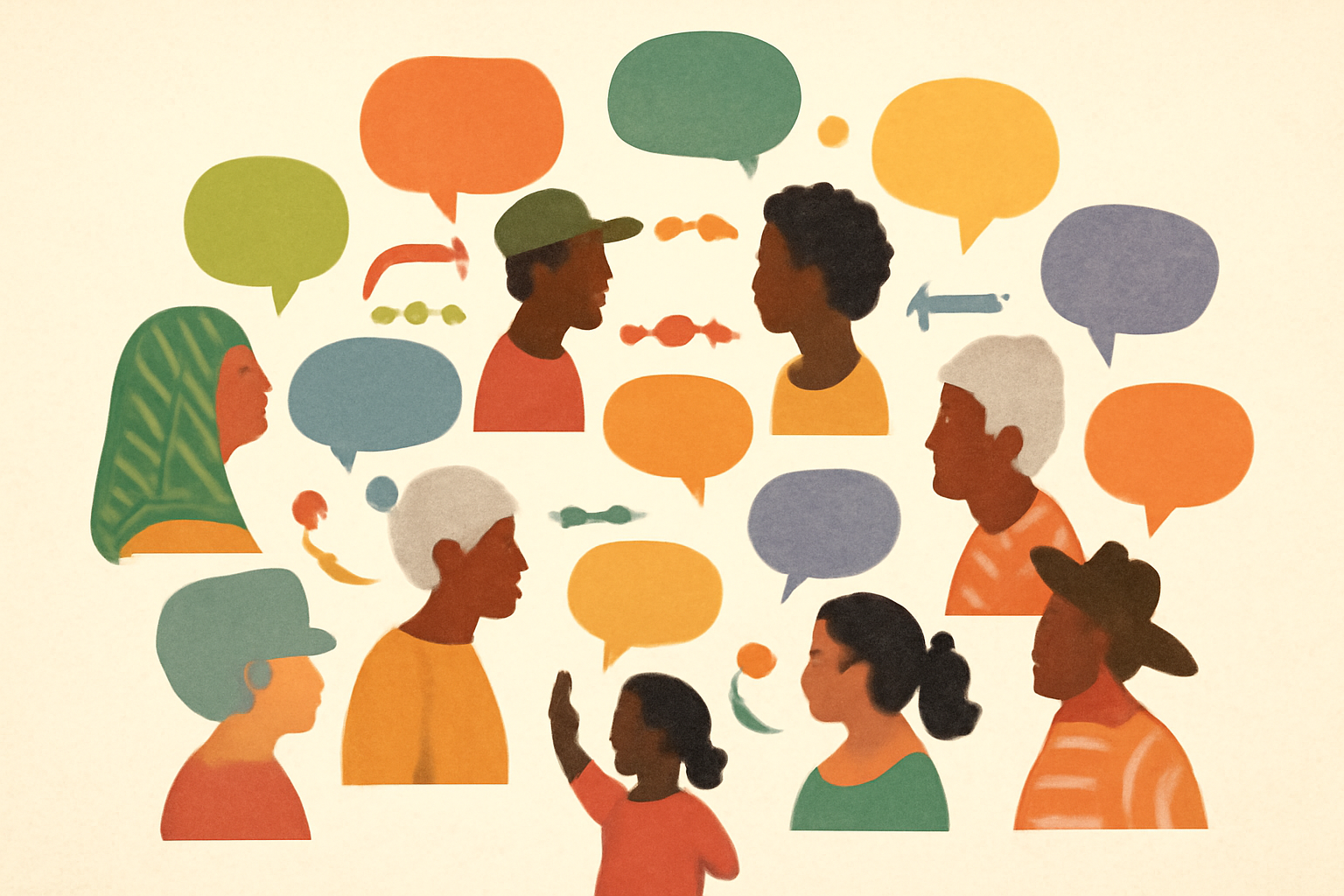 Bridge these gaps by developing cultural intelligence – the ability to adapt communication styles to different cultural contexts. Create team norms that acknowledge varying preferences, like establishing whether silence means disagreement or contemplation, or if direct feedback is appreciated or considered rude.
Bridge these gaps by developing cultural intelligence – the ability to adapt communication styles to different cultural contexts. Create team norms that acknowledge varying preferences, like establishing whether silence means disagreement or contemplation, or if direct feedback is appreciated or considered rude.
Remote and hybrid environments require deliberate communication practices. Ensure meetings give equal voice to virtual and in-person participants through digital facilitation tools and designated remote advocates. Document decisions and discussions in shared spaces accessible to everyone regardless of location or time zone.
Addressing implicit biases starts with awareness. Practice perspective-taking exercises where team members consider issues from different viewpoints. When misunderstandings occur, approach them with curiosity rather than judgment: “Help me understand your thinking on this approach.”
Visual communication tools like diagrams, process maps, and wireframes transcend language barriers and reduce misinterpretation. They provide concrete references that minimize cultural or linguistic confusion while making abstract concepts tangible for everyone.
Establishing Shared Goals and Accountability
Collaborative Goal-Setting Processes
When teams set goals together, they’re 3.6 times more likely to be fully committed to achieving them than when goals are simply handed down. The SMART framework (Specific, Measurable, Achievable, Relevant, Time-bound) works brilliantly for teams when each element is discussed openly. For team objectives, add another dimension: shared ownership. Each team member should be able to answer “How does my work contribute to this goal?”
Getting everyone involved in establishing priorities creates natural buy-in. Try this approach: have team members individually rank potential goals, then come together to discuss rankings and reach consensus. This discussion often reveals assumptions and concerns that might otherwise remain hidden.
During these priority-setting sessions, simultaneously develop the metrics you’ll use to measure progress. Questions like “How will we know we’re succeeding?” help teams create meaningful yardsticks that everyone understands and accepts.
Team goals must link clearly to broader organizational objectives.
 Create a simple visual that shows how team goals ladder up to department and company goals. Revisit this visualization regularly in team meetings to reinforce the connection between daily work and bigger-picture impact.
Create a simple visual that shows how team goals ladder up to department and company goals. Revisit this visualization regularly in team meetings to reinforce the connection between daily work and bigger-picture impact.
For driving performance, Objectives and Key Results (OKRs) provide a powerful framework. Unlike traditional goal systems, OKRs separate the what (objectives) from the how (key results). This distinction gives teams clarity on the destination while allowing flexibility in the journey – particularly valuable when collaboration requires adapting to each member’s working style.
Creating Meaningful Accountability Systems
Effective teams understand the difference between individual and collective accountability. Individual accountability means “I’ll deliver my part,” while collective accountability means “We’ll ensure the whole project succeeds.” Both are essential. Without individual accountability, people may hide behind the team; without collective accountability, you get siloed work that doesn’t integrate effectively.
Visual management tools transform abstract goals into tangible progress markers. Digital dashboards or physical boards with cards moving through stages help teams see bottlenecks and victories alike. The key is transparency – everyone should have the same view of progress and problems.
Peer-to-peer accountability conversations are often more effective than top-down management. According to Forbes, teams that establish regular, structured check-ins between members show 28% higher engagement. Create simple protocols for these conversations that focus on learning rather than blame.
Retrospectives – structured reflection sessions after project phases or regular intervals – provide space to assess what’s working and what isn’t. The basic format includes: What went well? What could improve? What actions will we take? This simple structure keeps teams continuously improving their collaboration.
Balancing Autonomy with Collective Responsibility
Decision-making authority should be crystal clear. Create a simple decision matrix showing which types of decisions can be made independently, which require consultation, and which need full consensus. This clarity prevents both bottlenecks and crossed wires.
Team interdependencies should be mapped visually.
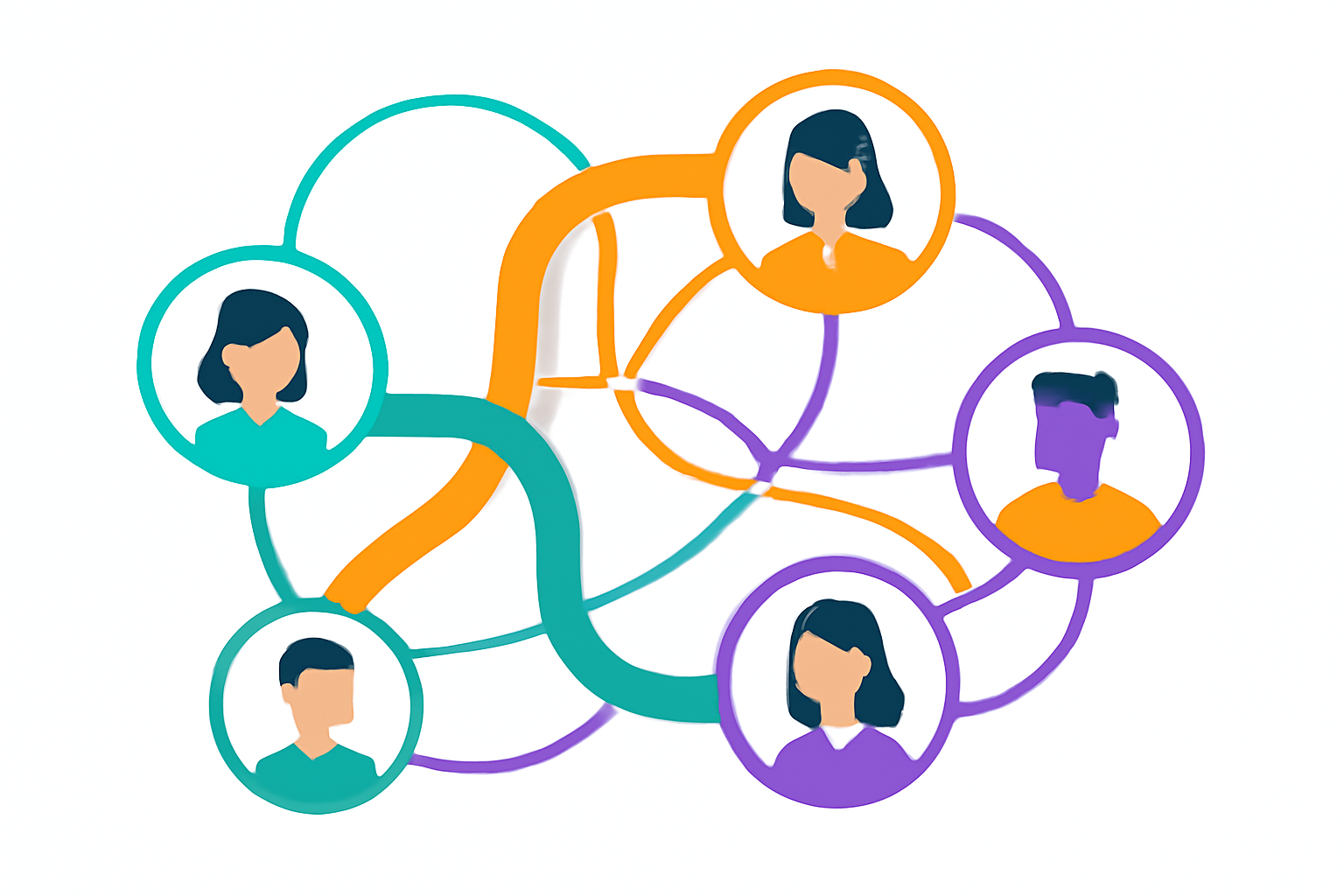 When everyone sees how their work impacts others, collaboration improves naturally. Update this map whenever processes change to keep it relevant.
When everyone sees how their work impacts others, collaboration improves naturally. Update this map whenever processes change to keep it relevant.
Establish clear escalation protocols for when team members hit roadblocks. Guidelines might include: Try to solve it yourself for 30 minutes, then ask a peer, then escalate to the team lead. This prevents small issues from becoming major delays while preserving autonomy.
Finally, recognition systems should balance individual achievements with team success. Celebrate personal wins in ways that acknowledge how they contribute to collective goals. This reinforces that individual excellence and team success aren’t competing priorities – they’re complementary forces.
Resolving Conflict and Building Team Resilience
Identifying and Addressing Conflict Early
Conflicts rarely appear out of nowhere. Like storm clouds gathering on the horizon, workplace tensions typically show warning signs before escalating into full-blown disputes.
 Team leaders should watch for changes in communication patterns – when team members who typically collaborate start avoiding each other, or when meeting participation suddenly drops. Other red flags include increased sarcasm, passive-aggressive comments, or team members forming opposing camps on issues.
Team leaders should watch for changes in communication patterns – when team members who typically collaborate start avoiding each other, or when meeting participation suddenly drops. Other red flags include increased sarcasm, passive-aggressive comments, or team members forming opposing camps on issues.
Creating environments where team members feel safe voicing concerns prevents conflicts from festering underground. Regular check-ins where team members can share frustrations without fear of repercussions work wonders. Some teams benefit from anonymous feedback systems that allow people to flag issues they might otherwise keep to themselves. Weekly “temperature checks” using simple red/yellow/green indicators can also help spot brewing tensions.
When conflicts do emerge, applying a structured approach makes resolution more likely. The Harvard Negotiation Project’s conflict resolution framework offers a practical model: separate people from problems, focus on interests rather than positions, generate options for mutual gain, and use objective criteria to evaluate solutions. This systematic approach transforms emotional standoffs into problem-solving conversations.
Sometimes conflicts run too deep for internal resolution. Bring in HR when conflicts involve harassment, discrimination, or company policy violations. Consider external mediators when conflicts become entrenched or when neutrality is crucial. These third parties bring fresh perspectives and specialized conflict resolution skills that can break deadlocks.
Transforming Conflict into Creative Opportunities
Teams with diverse thinking styles naturally generate different approaches to problems. While this diversity can spark disagreement, it also creates fertile ground for innovation. When managed effectively, these cognitive differences become assets. Teams that leverage constructive disagreement produce 40% more creative solutions than teams that avoid conflict.
Effective teams learn to focus on the content of disagreements rather than taking opposing views personally. Encourage phrases like “I see the problem differently” instead of “You’re wrong.” Train team members to critique ideas using specific, objective observations rather than broad judgments. Setting ground rules for debates – like requiring members to summarize others’ positions before responding – keeps discussions productive.
Structured debate formats can transform potential conflicts into innovation engines. Consider techniques like “Six Thinking Hats” where team members collectively wear different thinking “hats” (optimistic, cautious, creative, etc.) to examine problems from multiple angles. Or try “Red Team/Blue Team” exercises where groups deliberately argue opposing positions to strengthen the final solution.
Building Team Resilience Through Challenges
Resilient teams bounce back from setbacks stronger than before. Help your team develop healthy responses to failure by creating an “after-action review” process that focuses on learning rather than blame. Questions like “What can we learn?” and “How might we approach this differently next time?” transform disappointments into growth opportunities.
Mistakes should be treated as valuable data points rather than causes for shame. The American Psychological Association recommends celebrating “productive failures” – attempts that didn’t succeed but generated important insights. Some teams keep “lesson learned” logs that document both successes and failures, creating an organizational memory that prevents repeating mistakes.
Team adaptability can be strengthened through scenario planning exercises. Periodically ask your team: “What would we do if our key client left?” or “How would we adapt if our budget was cut by 30%?” These mental rehearsals build confidence in the team’s ability to handle whatever comes their way.
During times of change or crisis, maintaining team morale becomes critical. Regular recognition of small wins, creating space for appropriate humor, and transparent communication about challenges all help teams stay motivated through difficult periods.
Practical Team-Building Activities and Rituals
Purposeful Team-Building Exercises
Problem-solving challenges do more than just break office monotony—they build essential collaboration muscles. The “Blind Square” activity, where team members must form a perfect square with a rope while blindfolded, forces clear communication and leadership to emerge naturally.
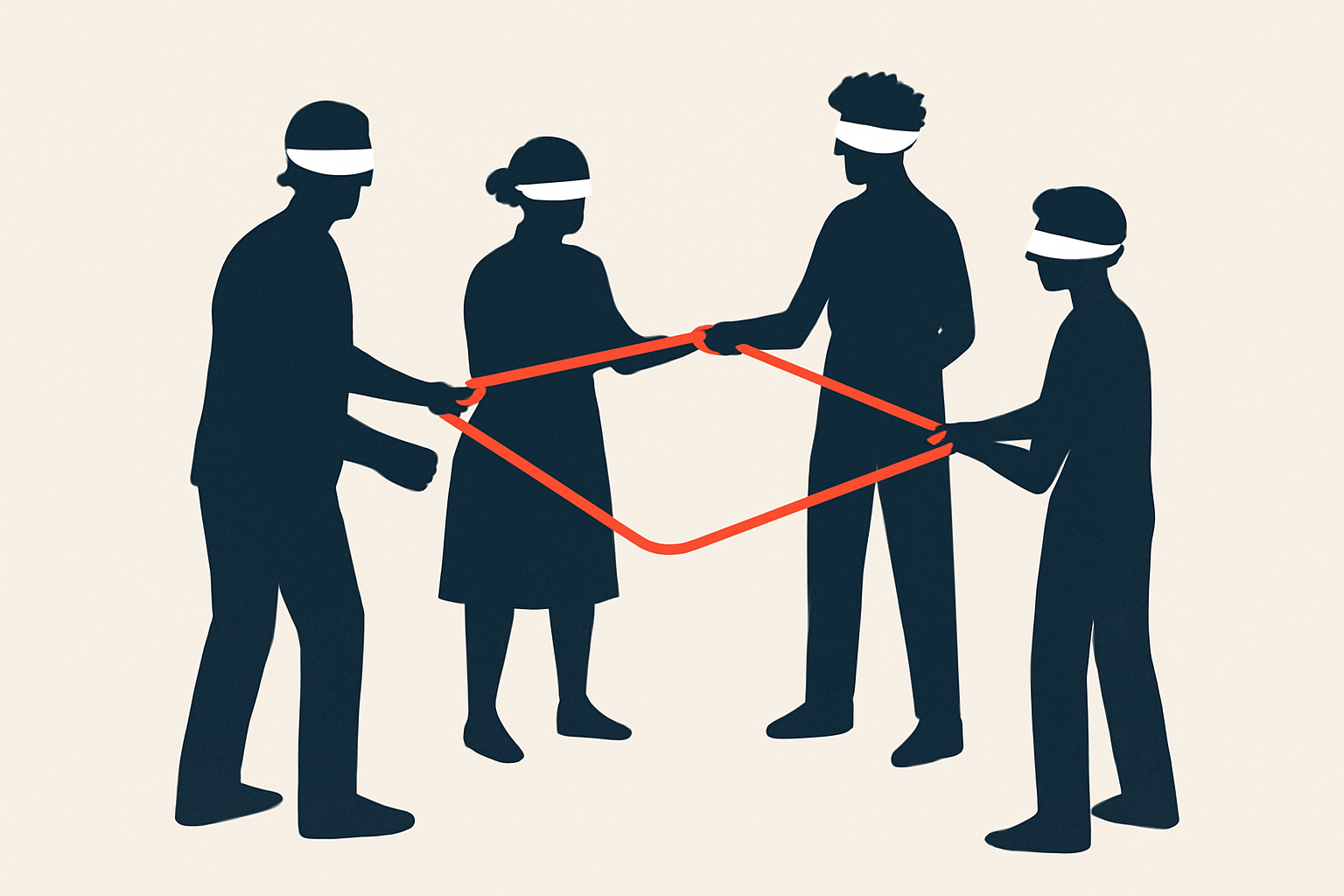 According to research by the Center for Creative Leadership, teams that regularly engage in structured problem-solving activities show a 27% increase in collaborative efficiency within three months.
According to research by the Center for Creative Leadership, teams that regularly engage in structured problem-solving activities show a 27% increase in collaborative efficiency within three months.
Communication exercises like “Back-to-Back Drawing” pair team members to describe and draw an image without seeing each other’s work. This simple activity highlights how differently we communicate and interpret information. Teams often discover communication gaps they never realized existed.
For trust-building, few exercises match the impact of “Trust Fall” variations. While the classic version works well, “Guided Blind Walks” (where blindfolded team members navigate obstacles with only verbal guidance from partners) creates measurable trust improvements. Teams can track progress by noting decreasing hesitation times and increasing complexity of successfully completed routes.
When selecting activities, match them to specific development needs rather than using generic exercises. A team struggling with siloed thinking benefits from cross-functional challenges, while one facing interpersonal tension needs trust-focused activities. Always debrief afterward with specific questions: “What worked? What didn’t? How does this reflect our daily work patterns?”
Establishing Meaningful Team Rituals
Daily stand-ups shouldn’t be status updates but connection points. The most effective teams spend 3-5 minutes sharing personal wins or challenges before diving into work matters. This brief investment pays dividends in team cohesion.
Weekly retrospectives should follow a consistent format like “Start-Stop-Continue” or “What went well, what didn’t, what we’ll change.” MIT research shows teams implementing structured retrospectives see a 32% reduction in recurring problems within six weeks.
Celebration rituals need not be elaborate. Some high-performing teams use “victory bells” that anyone can ring when completing significant work. Others maintain digital “win boards” where accomplishments get posted and publicly acknowledged. The key is consistency—celebrating both small wins and major milestones.
Thoughtful onboarding rituals dramatically reduce new member integration time. The “peer ambassador” approach, assigning an experienced team member as guide, cuts typical adjustment periods by nearly 40%.
Virtual and Hybrid Team-Building Approaches
Digital collaboration tools like Miro, MURAL, and Mentimeter enable remote teams to participate equally in brainstorming and decision-making.
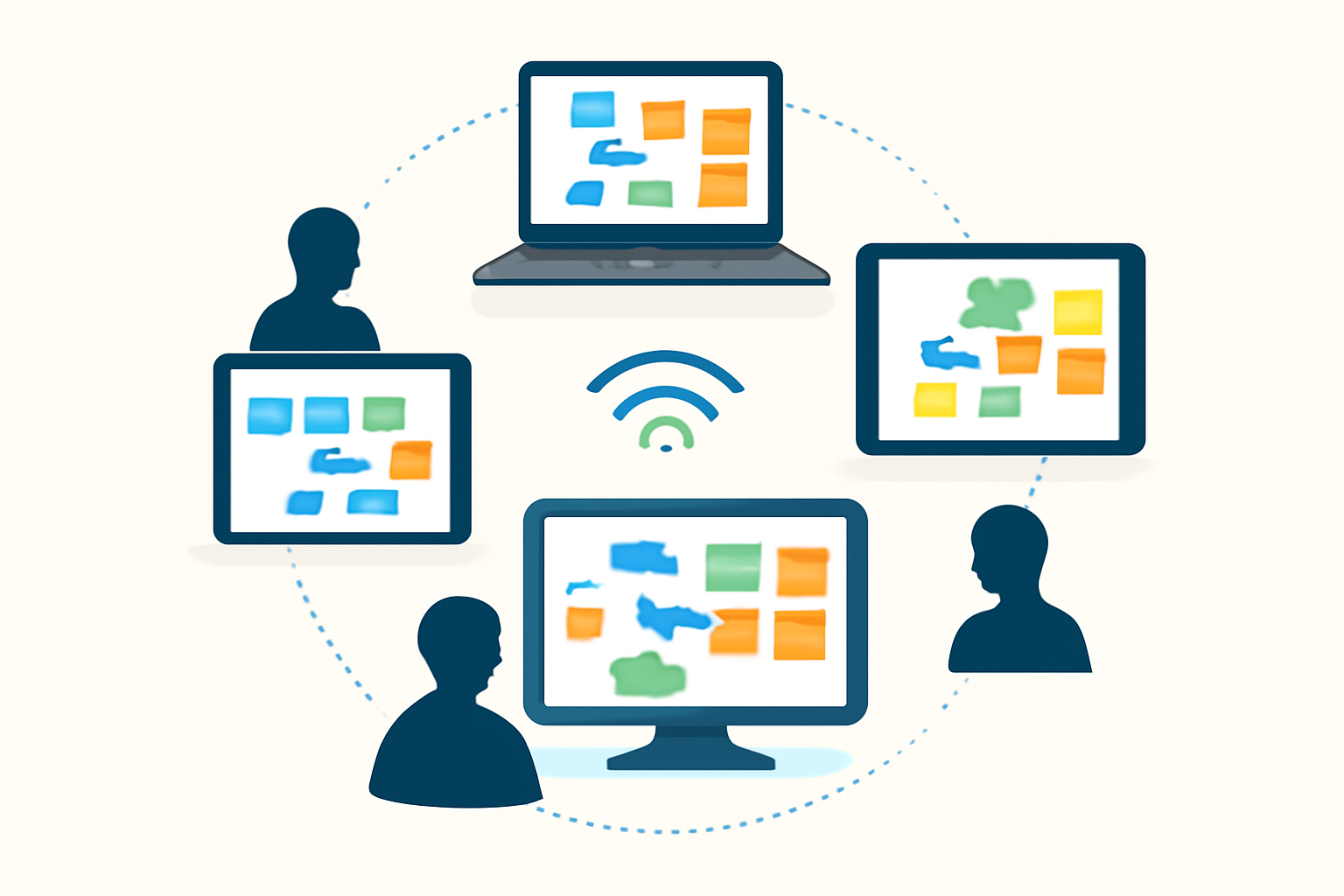 Visual collaboration boards preserve thinking patterns that would otherwise be lost in video calls.
Visual collaboration boards preserve thinking patterns that would otherwise be lost in video calls.
Creating equity between in-office and remote team members requires intentional design. “Remote-first” meeting protocols—where everyone joins from their own device, even if some are in the same physical space—prevent information imbalances. As Gartner’s research indicates, hybrid teams with equitable participation practices outperform office-centric teams by 16%.
Virtual social activities work best when interactive and purposeful. Virtual escape rooms and remote cooking classes consistently outperform passive activities like virtual happy hours for building cross-location relationships.
Measuring Team Development Progress
Regular assessment using frameworks like the Atlassian Team Health Monitor provides objective snapshots of team function. The most insightful assessments compare team self-ratings against external observations.
Track collaboration indicators like decision time, cross-functional idea implementation, and conflict resolution speed. Teams making genuine progress typically see these metrics improve by 15-20% within quarterly measurement periods.


